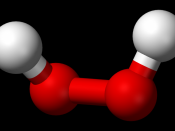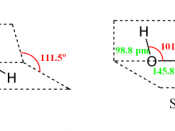For this investigation I have been asked to investigate (by experimentation) the effect of substrate concentrations on the rate of the decomposition of hydrogen peroxide when catalyzed by the enzyme catalase. This is part of our work on the function of enzymes, how they work and the effects of conditions on how they work. We have learnt about the formation of enzyme-substrate complexes, the lock and key model, induced fit model, activation energies of normal reactions and enzyme-catalyzed reactions, equilibrium, specificity and denaturation.
Let me write specifically about the enzyme, catalase and the substrate, hydrogen peroxide. In organisms, hydrogen peroxide is a toxic by-product of metabolism, of certain cell oxidations to be more specific. Hydrogen peroxide on its own is relatively stable and each molecule can stay in this state for a good few years. Its decomposition therefore needs to be speeded up greatly in order to prevent it from intoxicating the cell.
This is where catalase comes in.
Catalase has to be very fast acting to keep the hydrogen peroxide levels low, and it is one of the fastest acting enzymes known. It catalyses the decomposition of hydrogen peroxide, liberating oxygen gas as effervescence, each molecule of the globular protein decomposing 40,000 molecules of hydrogen peroxide per second atÃÂ zero degrees Celsius and capable of producing an amazing 1012 molecules of oxygen per second. The equation is:
2H2O2+Free enzymeëE-S complexî2H2O+O2+Free enzyme
The E-S complex is an intermediary stage where the substrate forms temporary and reversible interactions with the enzyme. The reason that this is so much faster than the decomposition rate in the absence of a catalyst is to do with the activation energy for this route being lower than the energy it takes to simply break the bonds within the molecules because it forms an intermediary stage, but...


